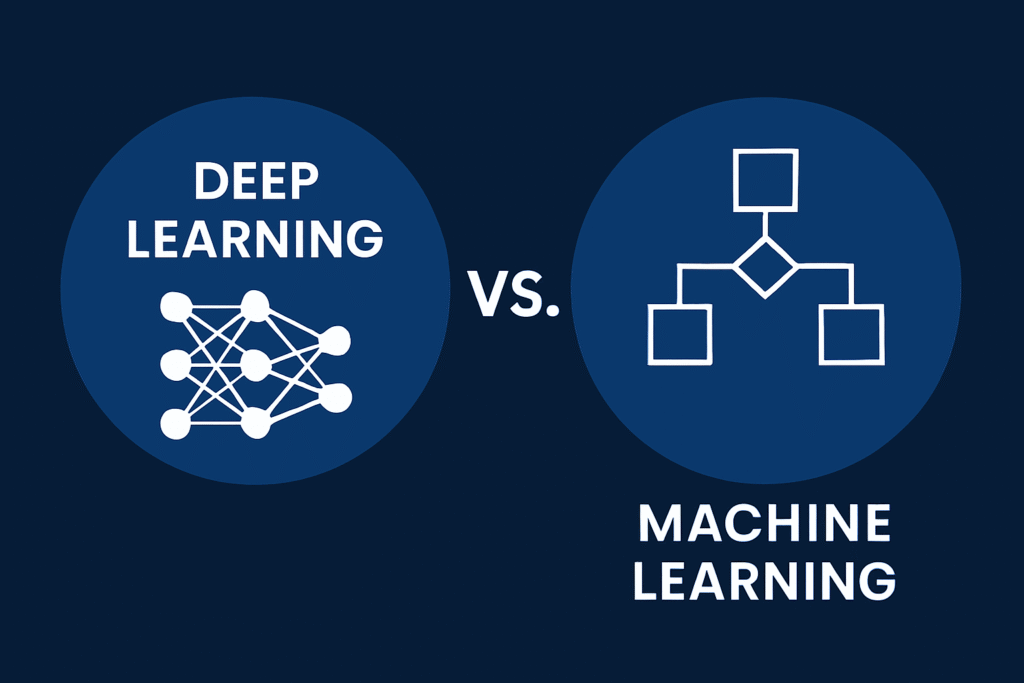Deep Learning vs. Machine Learning: What’s the Real Difference?
Ever wondered how Netflix predicts your next binge-worthy show or how your smartphone understands your voice commands? Chances are, machine learning or deep learning is behind it. These two branches of artificial intelligence (AI) are reshaping the world, yet many people still confuse the two.

I used to think they were basically the same thing. It wasn’t until I started digging into the details that I realized: deep learning and machine learning may share DNA, but they operate very differently and solve problems in surprisingly different ways.
In this blog post, I’ll break down the core differences, real-world applications, and when to use one over the other. Whether you’re a tech enthusiast, a business owner, or just someone curious about how AI works, this guide will help you understand these powerful tools in plain language.
What Is Machine Learning?
Machine learning (ML) is a subset of artificial intelligence. It allows systems to learn from data, identify patterns, and make decisions with minimal human intervention. Unlike traditional programming, where you explicitly tell the computer what to do, machine learning enables systems to improve their performance through experience.
Types of Machine Learning:
- Supervised Learning: You provide labeled data. For example, a dataset of emails marked as “spam” or “not spam”. The model learns to classify new emails based on that.
- Unsupervised Learning: The system is given data without labels and tries to find hidden patterns. Think of clustering customer data to identify different buyer personas.
- Reinforcement Learning: The system learns by trial and error, receiving rewards or penalties. This is how robots learn to walk or how AlphaGo defeated human champions.
Real-World Applications:
- Spam filters in Gmail
- Fraud detection in banks
- Personalized recommendations on Amazon
- Predictive maintenance in manufacturing
Machine learning works well with structured data and is often preferred for projects where explainability and speed are essential.
What Is Deep Learning?
Deep learning (DL) is a subset of machine learning. It uses multi-layered artificial neural networks to process data in complex ways. Inspired by the structure of the human brain, these models can automatically extract features from raw data, making them powerful for tasks like image and speech recognition.
Why “Deep”?
The “deep” in deep learning refers to the number of layers in the neural network. More layers mean the model can learn increasingly abstract representations of the data.
How It Works:
Let’s say you’re trying to build a system to recognize dogs in images:
- Traditional ML: You would manually define features like ears, nose, fur texture.
- Deep Learning: You feed in raw images, and the model figures out the features itself.
Real-World Applications:
- Facial recognition on smartphones
- Self-driving cars
- Voice assistants like Siri and Alexa
- Medical image analysis (e.g., detecting tumors in MRI scans)
Key Differences Between Machine Learning and Deep Learning
Here’s where things get more nuanced. Although deep learning is a type of machine learning, the differences in approach, capability, and resource requirements are significant.
1. Data Requirements
- ML: Can work with smaller datasets
- DL: Needs massive datasets to perform well
2. Hardware Dependency
- ML: Runs on traditional CPUs
- DL: Often requires powerful GPUs or TPUs for training
3. Feature Engineering
- ML: Requires manual effort to identify features
- DL: Automatically extracts features
4. Training Time
- ML: Faster to train, often in minutes or hours
- DL: Can take hours, days, or even weeks
5. Accuracy
- ML: Good for simple or structured problems
- DL: Outperforms ML on complex tasks like speech or image recognition
6. Interpretability
- ML: Easier to understand and debug
- DL: Often called a “black box” because it’s hard to explain how decisions are made
| Feature | Machine Learning | Deep Learning |
| Data Needs | Low to moderate | High (big data) |
| Hardware | CPU | GPU/TPU |
| Feature Engineering | Manual | Automated |
| Training Time | Fast | Slower |
| Accuracy | Good | Often better |
| Interpretability | High | Low |
When to Use Machine Learning vs. Deep Learning
Choose Machine Learning If:
- You have structured data like Excel sheets or SQL databases
- Your dataset is small to medium-sized
- You need fast results with explainable outcomes
- You’re solving simpler tasks like churn prediction or customer segmentation
Choose Deep Learning If:
- You’re working with unstructured data: images, video, audio, or natural language
- You have access to a lot of data and strong computational resources
- Your project involves complex pattern recognition, like detecting anomalies in X-rays
- You’re building advanced AI applications like autonomous vehicles or AI-powered chatbots
A Real-World Analogy: Teaching a Kid vs. Training a Prodigy
Imagine you’re teaching someone to recognize animals:
- With machine learning, you hand them flashcards labeled with animals and explain the distinguishing features.
- With deep learning, you drop them into a zoo with no instructions and let them observe. Over time, they start recognizing animals without any explicit teaching.
Machine learning requires more guidance, but it’s easier to understand how decisions are made. Deep learning takes more data and time but figures things out in a more human-like way.
Deep Learning and Machine Learning in Action: Case Studies
Healthcare
- ML: Used in predictive models to identify at-risk patients using structured medical records.
- DL: Used in radiology to detect cancer from imaging scans with high accuracy.
Finance
- ML: Detecting fraudulent credit card transactions based on spending patterns.
- DL: Forecasting stock prices using historical charts and social sentiment data.
Retail
- ML: Recommending products based on past purchases.
- DL: Personalizing entire user journeys using clickstream data and real-time behavior.
These examples show that ML and DL often complement each other. You might start with ML for quick wins and scale to DL when your business matures or the problem becomes more complex.
The Future: Not Either/Or but Both
One common myth is that deep learning will completely replace machine learning. In reality, they coexist and often work together. Many real-world systems use ML models for quick, interpretable insights and deploy DL models for deeper, more complex analysis.
The takeaway? Don’t think of ML vs. DL as a battle. Think of it as a toolkit. Use the right tool for the job, and you’ll save time, resources, and frustration.
Conclusion
So, what have we learned?
- Machine learning is great for structured problems with clear patterns and limited data.
- Deep learning excels in unstructured, high-complexity environments.
- The choice between the two depends on your data, goals, and resources.
Understanding the distinction isn’t just academic — it’s crucial for making informed decisions in tech, business, and beyond. Whether you’re choosing a platform for your startup, planning a data science project, or just leveling up your knowledge, knowing when to use ML or DL gives you a real edge.
Curious to dive deeper into either one? Let me know in the comments which area you’re most interested in, and I might just write the next guide around that!





